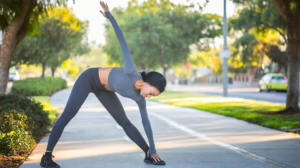The Hidden Dangers of Fitness Trends: What to Watch Out For
Introduction
In recent years, the fitness industry has exploded into a kaleidoscopic world of trends, diets, and workout programs, each promising miraculous results. From high-intensity interval training (HIIT) to the rise of fitness influencers on social media, people are being constantly bombarded with new ways to achieve their fitness goals. While some of these trends can offer real benefits, they often come with hidden dangers that can lead to physical injuries, mental health issues, and nutritional deficiencies. This article aims to explore the less visible aspects of popular fitness trends, providing readers with the knowledge to navigate this complex landscape safely.
The Rise of Quick Fixes: Instant Gratification in Fitness
In a society increasingly obsessed with instant gratification, fitness trends that promise rapid results have gained immense popularity. Programs like "30-day challenges" or "12-week transformations" often encourage people to push their bodies to the limit with minimal time investment. While these programs may seem appealing, they can lead to dangerous outcomes.
Unsustainable Practices
Many of these quick-fix solutions are fundamentally unsustainable. For instance, extreme calorie restriction, which is often a component of such diets, may lead to nutrient deficiencies over time. "Crash diets" can result in accelerated weight loss initially, but they often lead to a cycle of yo-yo dieting, where individuals regain the weight—and sometimes more—once they resume normal eating patterns.
Increased Injury Risk
Rapid workouts can also lead to injuries. If individuals are not conditioned for high-intensity training, they increase their risk for sprains, strains, and even more severe injuries such as stress fractures. A significant percentage of injuries arise from improper technique, often exacerbated by the competitive atmosphere in group classes, where participants may feel pressured to match the intensity of their peers.
The Influence of Social Media: Fitness Aesthetics vs. Real Health
In the age of social media, fitness influencers play a significant role in shaping public perception of health and wellness. Their lifestyles often serve as aspirational benchmarks, pushing individuals to adopt extreme measures in pursuit of the "ideal" body.
Cultivating Unhealthy Comparisons
One of the hidden dangers of this trend is the psychological toll it can take. Social media often promotes unrealistic body types, causing many to engage in unhealthy comparisons. Research indicates that prolonged exposure to such images can lead to body dissatisfaction, eating disorders, and decreased self-esteem.
Misinformation
Moreover, many influencers lack formal training in fitness or nutrition, often promoting products based on personal anecdotal experiences rather than scientific evidence. This can perpetuate myths about health and fitness, leading people down potentially harmful paths. For example, fad diets that promise the elimination of whole food groups may deprive individuals of essential nutrients, leading to long-term health issues.
The Dark Side of Group Workouts
While group workouts can provide motivation and camaraderie, they can also pose risks that are often overlooked.
Competitive Atmosphere
Group classes, particularly those led by charismatic trainers, can foster a competitive atmosphere that encourages overexertion. Participants may push themselves beyond their limits to keep up, leading to injuries. Furthermore, the group dynamic can mask individual needs and variations in fitness levels, making it challenging to provide proper modifications for those who may require them.
The ‘No Pain, No Gain’ Mentality
The phrase "no pain, no gain" is often misconstrued in fitness culture, leading many to believe that pain is a necessary part of progress. This mindset can result in ignoring signs of injury or fatigue, further exacerbating physical issues. In such an environment, individuals are less likely to listen to their bodies, increasing the risk of chronic injury.
The Allure of Popular Diets
Diets such as keto, paleo, and intermittent fasting are widely discussed and often celebrated within fitness communities. While they may offer some advantages, they also harbor hidden dangers.
Nutritional Deficiencies
Many trendy diets promote the exclusion of entire food groups. For example, the keto diet emphasizes a high-fat, low-carb intake, which can lead to deficiencies in fiber, vitamins, and minerals if not carefully managed. The paleo diet encourages the consumption of unprocessed foods but may lead to inadequate calcium intake if dairy products are excluded. Moreover, intermittent fasting may not be suitable for everyone and can lead to overeating during non-fasting hours, resulting in weight gain instead of loss.
Psychological Effects
Restriction-based diets can also lead to a problematic relationship with food. The stress of adhering to strict rules may trigger binge eating or other disordered eating behaviors. The cycle of restriction and binge eating can create a harmful pattern that is difficult to break, leading to long-term mental and physical health issues.
Gadgets and Gear: Do They Help or Hinder?
With the rise of fitness technology, such as smart watches, fitness trackers, and wearable devices, individuals now have unprecedented access to data regarding their health and activity levels. However, reliance on these gadgets can come with its own set of dangers.
Obsession with Data
While data can provide insights into physical performance, an overreliance on tracking can lead to obsessive behaviors. Individuals might become fixated on reaching certain numbers, such as steps taken or calories burned, rather than listening to their bodies and engaging in mindful fitness practices. Such obsession can culminate in anxiety and unhealthy behaviors.
Misleading Statistics
It’s also important to recognize that wearable technology is not always accurate. Inaccurate tracking could lead individuals to either push too hard or not hard enough, jeopardizing their health and progress. Understanding that these devices provide approximations rather than definitive measurements is crucial for maintaining a healthy relationship with technology in fitness.
The Trend of Home Workouts
The COVID-19 pandemic accelerated the trend of home workouts, with fitness apps and online programs experiencing a surge in popularity. While this offers convenience, it also comes with hidden pitfalls.
Lack of Professional Guidance
Without the presence of a trainer to provide corrections and modifications, individuals may risk improper form when exercising at home. This not only increases the risk of injury but also reduces the effectiveness of the workout itself. Programs may not cater to individual fitness levels, leading to either excessive strain or ineffective training.
Social Isolation
Home workouts can lead to increased feelings of social isolation, which may take a toll on mental health. Group workouts provide a sense of community that can be motivating and uplifting. When people primarily exercise alone, they might miss out on these benefits, which can discourage long-term adherence to fitness routines.
Conclusion
In a world saturated with fitness trends, it is crucial to approach new programs, diets, and technologies with a critical eye. While many trends offer legitimate benefits, they often come with hidden dangers that could undermine both physical and mental well-being. Prioritizing safety, sustainability, and an individual’s unique needs is essential.
To effectively navigate this landscape, individuals must educate themselves, consult trained professionals, and develop a balanced, personalized approach to their fitness journeys. By doing so, they can cultivate a healthier relationship with movement, nutrition, and their bodies, leading to lasting, meaningful growth in their fitness endeavors.
References
-
American College of Sports Medicine. (2020). "The Science of Strength Training: Basics and Beyond."
-
National Institutes of Health. (2018). "The Obesity Epidemic: Causes and Consequences."
-
Harvard Health Publishing. (2019). "The Real Risks of Fad Diets: What You Need to Know."
-
Mayo Clinic. (2021). "Exercise for Weight Loss: Calories Burned in 30-Minute Activities."
-
American Psychological Association. (2020). "Eating Disorders: A Community Health Issue."
- Centers for Disease Control and Prevention. (2022). "The Importance of Physical Activity for Mental Health."
By being aware of these hidden dangers in fitness trends, readers can make informed choices that support their health and well-being.


























Add Comment